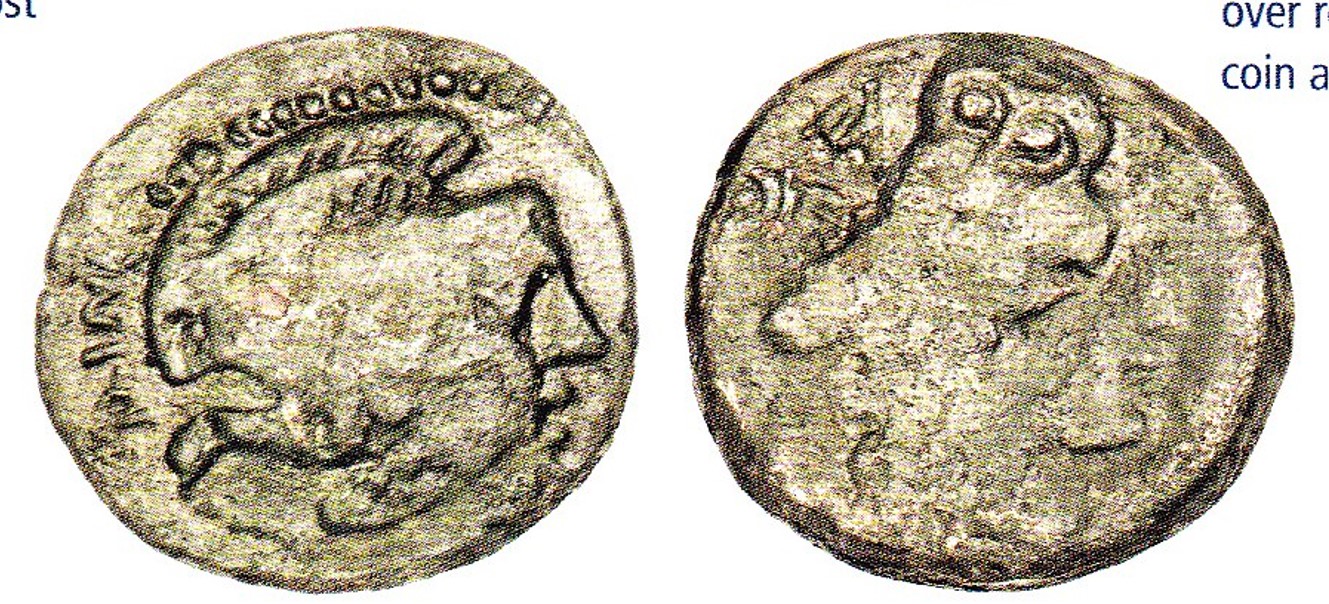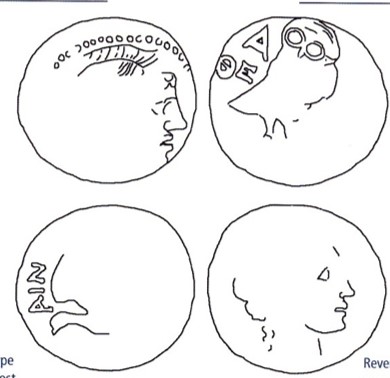3115 - Athens (AE Athena/owl) over Sicyon (Apollo/dove) (MacDonald coll., 112)
From SILVER
20 BCE - 19 BCE | AΘE
Images
Overstruck variety Traces of the overstruck variety
Traces of the overstruck variety

Ref_Sicyone_(apollo_dove).png [1]
Location/history
| Private collection(s)Private collection(s) ᵖ: | D. MacDonald coll., n°112 |
Overstriking coin
Description
| ObverseInscription or printing placed on the obverse.: | Head of Athena Parthenos right, wearing crested Attic helmet. Border of dots. | ReverseInscription or printing placed on the reverse.: | AΘE (Greek) Owl three-quarters right on prow, head facing. |
Mint and issuing power
| MintIdentifies the place of manufacture or issue of a numismatic object.: | Athens | Ancient regionAncient region. | Attica | Modern countryModern country: Greece | AuthorityIdentifies the issuing power. The authority can be "pretended" when the name or the portrait of X is on the coin but he/she was not the issuing power. It can also be "uncertain" when there is no mention of X on the coin but he/she was the issuing power according to the historical sources: |
Chronology
| FromIdentifies the initial date in a range assigned in a numismatic context. 20 BCE toIdentifies the final date in a range assigned in a numismatic context.. 19 BCE | Hellenistic 323-30 BC |
Physical description
| MetalThe physical material (usually metal) from which an object is made.: Bronze |
WeightWeight of the numismatic object (in grams). in grams: 4.054.05 g <br />4,050 mg <br /> | ||
| StandardStandard.: Attic | |||
References
| Coin referenceReference of the Coin: | MacDonald 2009, p. 152-153, n° 112 | Coin series referenceReference to coin series study: | Kroll 19931Kroll 1993, n°115-126 |
| Coin series web referenceCoin series web references: | |||
Overstruck type
Description
| ObverseInscription or printing placed on the obverse.: | Head of Apollo, right. | ReverseInscription or printing placed on the reverse.: | AIN (Greek) dove in flight, left. |
Mint and issuing power
| MintIdentifies the place of manufacture or issue of a numismatic object. ᵖ: | Sicyon | Ancient regionAncient region. ᵖ | Peloponnesus | Modern countryModern country: Greece | AuthorityIdentifies the authority in whose name (explicitly or implicitly) a numismatic object was issued. ᵖ: |
Chronology
| FromIdentifies the initial date in a range assigned in a numismatic context. 100 BCE toIdentifies the final date in a range assigned in a numismatic context.. 30 BCE | Hellenistic 323-30 BC |
Physical description
References
| Coin type referenceReference to coin series study ᵖ: | BMC Attica2BMC Attica, p. 92, n° 669-670, Warren 19843Warren 1984, Group 12, Kroll 19931Kroll 1993, n° 727. | ||
| Coin series web reference overstruckCoin series web references overstruck: | |||
Additional data
| Frequency of overstrikesFrequency of overstrikes: | frequent | Level of confidenceLevel of confidence of the identification: | sure |
| RemarksRemarks: | "Shortly after Actium and the restoration of peace, Athens struck several very large bronze issues, and among them a small proportion of one variety was overstruck on a single variety of Sicyonian bronze, which had been issued at least half a century earlier. [...] Kroll has suggested that the government of Athens might have acquired a group of this specific variety [...] and long retained them before overstriking" | ||
References
- a b Kroll, John H. (1993), The Greek coins, Athenian Agora vol. 26, Princeton, xxvi + 376 p., 36 pl.
- ^ Head, V. Barclay (1888), British Museum. A Catalogue of the Greek coins in the British Museum. vol. VII : Attica - Megaris - Aegina, London, lxix, p.174 pl., 25.
- ^ Warren, Jennifer A. W. (1984), "The autonomous bronze coinage of Sicyon (part 2)", The Numismatic Chronicle,144, p.1-24, pl. 1-3.

